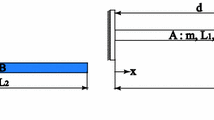Abstract
The demand for modular tools in machining operations has been increasing, owing to their flexibility, reduced cost, and productivity improvements when compared to solid carbide tools. Essentially, modular tools are interchangeable cutters that are assembled together with a joint. The effects of joint dynamics are often neglected when characterizing the dynamics of assembled mechanical systems, due to the assumption of rigid connections. In such cases, deviations between real and predicted system dynamic responses are inevitable. To prevent chatter vibration in machining operations, the accurate prediction of the dynamics of the tools is critical. In this study, the classic receptance coupling technique is enhanced by identifying the joint dynamics between substructures through experimental and finite-element (FE) analyses. The rotational dynamics of a substructure is indirectly identified using a gauge tool. The characteristics of a fastener joint (such as mass, spring and damping elements) are identified. Further, with the identified joint dynamics, the dynamic properties of the modular tools with the new interchangeable carbide tools are also predicted. Various experiments have been performed to verify the effectiveness of the joint identification method for modular tools. The method enables designers to optimize dynamic behaviour in the conceptual design stage of modular tools to improve productivity while minimizing chatter vibrations.
Similar content being viewed by others
References
Destefani J (2001) Milling tools go modular. SME Manuf Eng V126(6), June
Tlusty J, Koenigsberger F (1967) Machine tool structures. Pergamon Press, Oxford
Altintas Y (2000) Manufacturing automation: Metal cutting mechanics, machine tool vibrations, and CNC design. Cambridge University Press, New York
Rivin EI (2000) Tooling structure-interface between cutting edge and machine tool. Ann CIRP 49(2):591
Shen J, Astaneh-Asl A (2000) Hysteresis model of bolted-angle connections. J Constr Steel Res 54:317–343
Kim TR, Ehmann KF, Wu SM (1991) Identification of joint structural parameters between substructures. J Eng Ind 113:419–424
Yuan JX, Wu SM (1985) Identification of the joint structural parameters of machine tool by DDS and FEM. ASME J Eng Ind 107:64
Liu W, Ewins DJ (2002) Substructure synthesis via elastic media. J Sound Vib 257(2):361–379
Wang J, Sas P (1990) A method for identifying parameters of mechanical joints. J Appl Mech 57:337–342
Park S, Altintas Y, Movahhedy M (2003) Receptance coupling for end mills. Int J Mach Tools Manuf 43:889–896
Gialamas T, Tsahalis D, Bregant L, Otte D, Van der Auweraer H (1996) Substructuring by means of FRFs: some investigations of the significance of rotational DOFs. MAC-XIV, Orlando, Florida, USA, 12–15 February, 1996, 1:619–624
Ma X, Bergman L, Vakakis A (2001) Identification of bolted joints through laser vibrometry. J Sound Vib 246:295–316
Tsai JS, Chou YF (1988) The identification of dynamic characteristics of a single bolt joint. J Sound Vib 125:487–502
Shamine DM, Hong SW, Shin YC (2000) An in situ modal-based method for structural dynamic joint parameter identification. Proc Inst Mech Eng 2114:613–653
Craig RR (1981) Structural dynamics: an introduction to computer methods. Wiley, New York
Chen W-H, Cherng J-S (1985) Modal synthesis via combined experimental and finite element techniques with consideration of rotational effects. J Sound Vib 103:1–11
Wang JH, Chuang SC (2004) Reducing errors in the identification of structural joint parameters using error functions. J Sound Vib 273:295–316
Durate MLM, Ewins DJ (2000) Rotational degrees of freedom for structural coupling analysis via finite difference technique with residual compensation. Mech Syst Signal Process 14:205–212
Ren T, Brards CF (1995) On substructure synthesis with FRF data. J Sound Vib 185(5):845–866
Schmitz TL, Donaldson R (2000) Predicting high-speed machining dynamics by substructure analysis. Ann CIRP 49:303–308
Schmitz TL, Davies M, Kennedy MD (2002) Tool point frequency response prediction for high-speed machining by RCSA. J Manuf Sci Eng 123:700–707
Harris CM (1997) Material damping and slip damping. In: Shock and vibration handbook, 2nd edn. McGraw-Hill, New York
Avitabile P (2002) Twenty years of structural dynamic modification. Proc of 20th IMAC, Los Angeles, USA, pp 356–372
Park SS (2006) Identification of spindle integrated force sensor’s transfer function for modular end mills. ASME Trans J Manuf Sci Eng 128:146–153
Camponmanes M (1998) Dynamics of milling flexible structures. Ma Sc Thesis, UBC
Mottershead JE, Friswell MI, Ng GH, Brandon JA (1996) Geometric parameters for finite-element model updating of joints and constraints. Mech Syst Signal Process 10(2):171–182
Song T, Hartwigsen CJ, Mcfarland DM, Vakakis AF, Bergman LA (2004) Simulation of dynamics of beam structures with bolted joints using adjusted Iwan beam elements. J Sound Vib 273:249–276
Hanss M, Oexl S, Gaul L (2002) Identification of a bolted-joint model with fuzzy parameters loaded normal to the contact interface. Mech Res Commun 29:177–187
Matlab (2001) Symbolic toolbox. The Mathworks
Wang JH, Chuang SC (2004) Reducing errors in the identification of structural joint parameters using error functions. J Sound Vib 273:295–316
Spector VA, Flashner H (1990) Modeling and design implication of noncollocated control in flexible systems. Trans ASME 112:186–193, June
Kim SM, Ha JH, Jeong SH, Lee SK (2001) Effect of joint conditions on the dynamic behavior of a grinding wheel spindle. Mach Tool Manuf 41:1749–1761
Press WH, Flannery BP, Teukolsky SA, Vetterling WT (1992) Numerical recipes in Fortran: the art of scientific computing, 2nd edn. Cambridge Press, Cambridge, pp 183, 644–645
Duarte M LM, Ewins DJ (2000) Rotational degrees of freedom for structural coupling analysis via finite-difference technique with residual compensation. Mech Syst Signal Process 14(2):205–227
Kops L, Vo DT (1990) Determination of the equivalent diameter of an end mill based on its compliance. Ann CIRP 93–96
Acknowledgements
This work was supported by the Natural Sciences and Engineering Research Council of Canada (NSERC) and the Alberta Ingenuity Fund (AIF). The authors also wish to thank Mr. Taro Abe from Mitsubishi Materials Co., Japan, and Ms. Karen Levitt from General Dynamics Canada.
Author information
Authors and Affiliations
Corresponding author
Rights and permissions
About this article
Cite this article
Park, S.S., Chae, J. Joint identification of modular tools using a novel receptance coupling method. Int J Adv Manuf Technol 35, 1251–1262 (2008). https://doi.org/10.1007/s00170-006-0826-6
Received:
Accepted:
Published:
Issue Date:
DOI: https://doi.org/10.1007/s00170-006-0826-6



